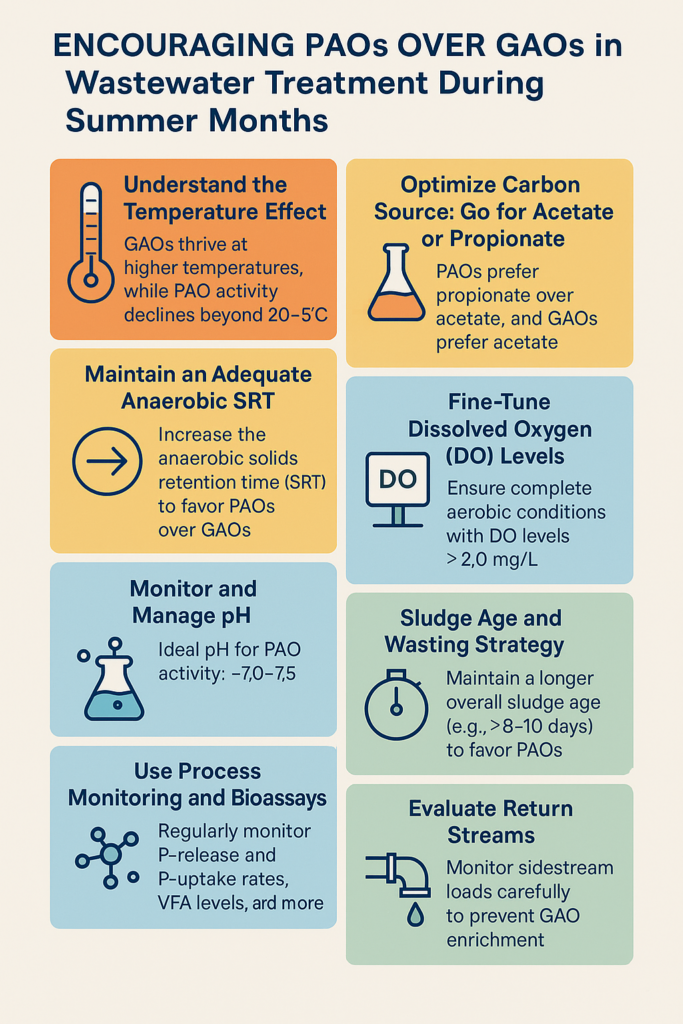
As the temperature rises during the summer months, wastewater treatment operators often face a hidden biological battle—Polyphosphate-Accumulating Organisms (PAO) versus Glycogen-Accumulating Organisms (GAO). In Enhanced Biological Phosphorus Removal (EBPR) systems, PAO remove phosphorus. GAO on the other hand, can compromise phosphorus removal by outcompeting PAO for volatile fatty acids (VFA), especially when conditions tilt in their favor—like during warm weather.
Here’s how to shift the balance and encourage PAO dominance during the heat of summer.
- Understand the Temperature Effect
While both PAO and GAO are mesophilic organisms, PAO growth is favored by lower temperatures than GAO. GAO thrive at higher temperatures (above ~25°C), while PAO activity often declines beyond 25°C. As summer temperatures rise, microbial community dynamics shift, potentially favoring GAOs if no adjustments are made. - Optimize Carbon Source
PAO prefer propionate over acetate, and GAO prefer acetate. Where possible, modify primary fermentation processes to favor propionate production in your VFA feed. Alternatively, supplement with external carbon (e.g., sodium propionate) to favor PAO. - Maintain an Adequate Anaerobic Residence Time
GAOs grow faster than PAOs, especially in warm conditions. To counter this:- Increase the anaerobic zone hydraulic retention time (SRT) to give PAO a competitive edge.
- Avoid excessively low overall SRTs that favor faster-growing GAOs.
- Monitor and Manage pH
Ideal pH for PAO activity: ~7.0–7.5
GAO prefer slightly lower pH (~6.5–7.0).
Maintain pH on the higher end of this spectrum using alkalinity adjustment or chemical dosing (e.g., sodium hydroxide or lime). - Fine-Tune Dissolved Oxygen (DO) Levels
Ensure complete aerobic conditions in the aerobic phase to fully oxidize stored PHA and promote phosphate uptake by PAOs. Target DO levels of 2.0 mg/L or higher during the aerobic phase for optimal PAO activity. - Use Process Monitoring and Bioassays
Regularly monitor:- P-release and P-uptake rates
- PHA and glycogen levels
- VFAs in anaerobic zones
- Molecular testing to evaluate PAO vs GAO populations
- Sludge Age and Wasting Strategy
Maintain a longer overall sludge age (e.g., >8–10 days) to favor PAOs. - Evaluate Return Streams
Sidestreams (e.g., from dewatering) may contain high nitrogen and VFAs—monitor and manage these loads carefully to prevent GAO enrichment.
Summer conditions can subtly tip the balance toward GAOs, jeopardizing EBPR performance. However, with proactive process control—including managing temperature impacts, carbon sources, SRT, pH, and oxygen—you can help PAOs maintain dominance.
Winning the summer microbial tug-of-war means understanding the needs of your beneficial microbes and shaping the process environment to their favor. With these strategies, you can keep your phosphorus removal strong all summer long.
Need Help Troubleshooting Your EBPR System This Summer?
Reach out to your process engineer or drop a comment below—we’re here to help you stay in control of your bugs, year-round.
